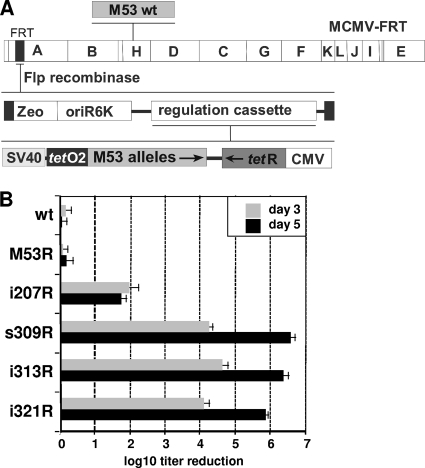FIG. 2.
Effect of conditional expression of inhibitory M53 mutants on virus growth. (A) Schematic representation of the conditional cassette used for regulated expression of the M53 mutants. The M53 mutants (M53 alleles) were cloned into the SV40 enhancer-based conditional expression cassette of a vector plasmid carrying an FRT site (modified after Rupp et al. [37]). These constructs were delivered to the MCMV BAC by Flp recombination at an FRT site located between the m16 and m17 genes within the HindIII A fragment as described previously (36, 37). The wt M53 gene is located within the HindIII H fragment. Permissive cells are transfected with the recombinant BACs to reconstitute the viruses carrying the regulation cassettes of M53 mutants. The M53 mutants are not expressed during virus reconstitution, because the constitutively expressed tetracycline repressor (tetR) blocks their transcription. Upon dox administration, tetR is inactivated and the DN M53 mutants are expressed under the control of the SV40 promoter (SV40e-tetO2). (B) Effects of the M53 inhibitory mutants on the production of viral progeny. M2-10B4 cells were infected for 5 days at an MOI of 0.1 in either the absence or the presence of 1 μg/ml dox. Wt MCMV was used as a positive control for infection and a negative control for dox toxicity. In addition, the virus overexpressing the wt M53 allele represented the control for M53 overexpression. Cell supernatants were collected on the indicated days postinfection, and the released infectious units were determined by titration on MEFs. The balcony diagram shows the regulation of virus growth in response to dox administration 3 days or 5 days after infection with the indicated constructs. The titer reduction induced by dox is shown as a ratio between the titer in the absence of dox and the titer in the presence of dox. Only titer reductions of >10-fold were considered significant. Each mutant was analyzed in duplicate in at least two independent experiments. The error bars indicate standard deviations.

